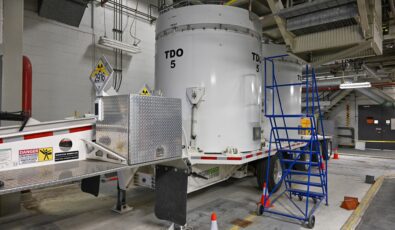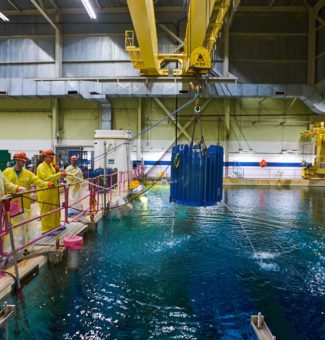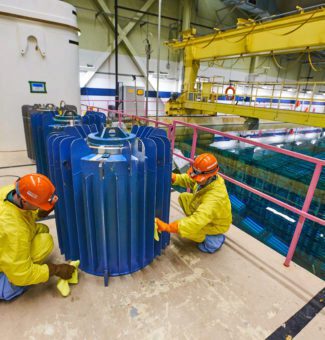Isotopes from OPG’s nuclear stations helping to unlock the promise of nuclear fusion
At a glance
- OPG’s nuclear stations are among the world’s only sources of tritium and other important isotopes.
- Demand for tritium is now growing as it is a critical fuel for nuclear fusion, a potential clean energy source for the future.
- OPG is leveraging isotopes to advance nuclear sustainability and the well-being of society.

For decades, OPG’s CANDU nuclear reactors have provided clean, reliable, and safe power for millions, as well as important radioactive isotopes for the world.
Today, these reactors and the isotopes they produce are helping to unlock the next major technological advances in energy and computing. It’s just one of the ways OPG’s nuclear operations are forging a path toward a sustainable future.
One of the isotopes quickly gaining prominence is tritium, a radioactive isotope of hydrogen that occurs naturally as well as a by-product of the daily operations of a CANDU reactor.
“We used to predominantly look at tritium as waste,” said Jason Van Wart, Senior Vice-President of Nuclear Sustainability at OPG. “Tritium is an extremely valuable asset, with many applications. Demand for this isotope is only growing as it is a critical fuel for nuclear fusion – and OPG has the world’s only non-military supply of this isotope.”
Formed in the heavy water that sustains the nuclear chain reaction in CANDU reactors, tritium from Ontario’s CANDU fleet and research facilities is extracted, concentrated, and safely stored in canisters in a concrete vault in OPG’s Tritium Removal Facility at the Darlington Nuclear station, the world’s largest tritium processing facility.
“We used to predominantly look at tritium as waste. Tritium is an extremely valuable asset, with many applications. Demand for this isotope is only growing as it is a critical fuel for nuclear fusion – and OPG has the world’s only non-military supply of this isotope.”Jason Van Wart, Senior Vice-President of Nuclear Sustainability at OPG
The tritium extraction process reduces radiological dose to workers and emissions to the environment, but also helps provide a beneficial product to the world.

For three decades, OPG has made tritium commercially available for use in self-powered lights, as a source for luminescence in watches, and for medical research.
Now, the isotope is helping to advance the next generation of clean energy development as a key ingredient in achieving nuclear fusion by combining with another key ingredient, deuterium, or heavy water.
By harnessing the same process that powers the sun and stars, nuclear fusion reactors look to produce power from fusing lighter atoms with heavier ones, releasing huge amounts of clean, emission-free energy.
International research into this potential energy source of the future continues to accelerate, along with the demand for OPG’s tritium stockpile.
“We expect to see this demand really get going by the 2030s, when the first fusion power plants to deliver electricity to the grid are predicted to be up and running,” Van Wart said.
As it decays, tritium also produces another valuable and extremely rare isotope, helium-3, which is helping to support quantum computing research and could also be a potential fuel source in fusion reactors.

While the moon is expected to house large deposits of helium-3 due to being exposed to solar winds for billions of years, this non-radioactive and inert gas doesn’t naturally form on Earth.
Rather than make costly expeditions to the moon, OPG’s subsidiary Laurentis Energy Partners uses a custom-designed tool to extract helium-3 from tritium stored at Darlington Nuclear, selling the helium-3 to strategic partner and distributer Air Liquide.
Today, it’s used in Magnetic Resonance Imaging (MRI), in border security to detect radioactive materials, and in quantum computing to reach near-absolute-zero temperatures, which reduces noise and interference in calculations.
And this is just one of the isotopes created in OPG’s nuclear stations that are helping to save lives, improve safety, and enrich society. Other important isotopes include Cobalt-60, used to sterilize 40 per cent of the world’s single-use medical devices, and Molybdenum-99, used in more than 30 million diagnostic and medical imaging treatments.
Heavy water, the isotope so vital to sustaining the chain reaction in CANDU reactors, also plays an important role outside of the reactor, as it enhances MRIs and helps pharmaceuticals last longer in the bloodstream.
OPG continues to explore other opportunities to extract tritium from its nuclear operations for use in the high-tech and medical industries.
“These are the major sustainability initiatives that we are continuing to advance as a company,” said Van Wart. “We are safely managing the used fuel from our nuclear operations, finding innovative ways to reduce and shrink the low- and intermediate-level by-products that make up 90 per cent of nuclear waste, and leveraging important isotopes for the advancement and well-being of our society.”
Subscribe and stay informed
Sign up to receive the latest news, project updates, and event information from OPG.


